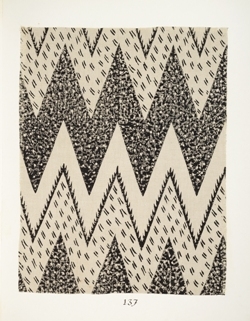Linda Brassington
Phylis Barron and Dorothy Larcher’s block printed textiles represent an important development of English craft in the 20th century. The preservation of their textiles, produced in the inter-war years by the “blue print” technique, was one of the central aims of the university Crafts Study Centre established in 1970. Founder trustee, Robin Tanner, had the work of these two visual artists documented (resulting in two detailed volumes of printed samples) and passed their textile collection from different continents and cultures to the textile collection of the newly established University for the Creative Arts in Farnham.
While much of 1930‘s Modernism disregarded decoration, pattern remained fundamental to Barron and Larcher’s textiles. Their block printed cloths go beyond the literal reproductions of traditional blue print textiles. The quality of line in their design work is exceptional. Perhaps some of Barron and Larcher’s most striking works are their simple, monochrome prints with strong, directional elements. Spine, Large Chevron and Unnamed Lozenge are powerful and timeless compositions. Their work expresses a joy for pattern that is typical of English textiles. These quiet and domestic English block prints made a discreet, but significant contribution to the development of British textile design in the late 20th century.
